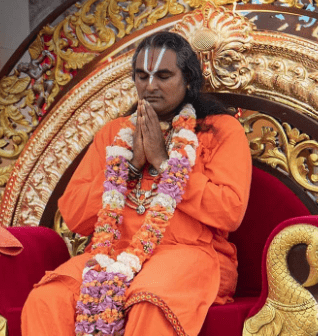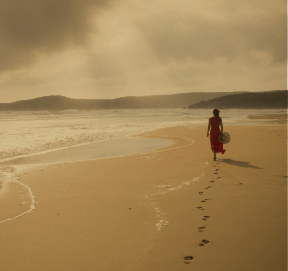Essentially, we all love God and strive to realise Him by making Him the constant focus of our thoughts, words and deeds. To varying degrees, we each recognise Paramahamsa Vishwananda as someone who lives in constant union with God, and so we seek His shelter and grace as we walk the path of bhakti under His guidance.
What is a Hari Bhakta?
In short, a 'Hari Bhakta' is a lover of God. As initiated devotees, we strive to follow the teachings and path to God prescribed by Paramahamsa Sri Swami Vishwananda, who is the founder of the Hari Bhakta Sampradaya.
'This path of the Hari Bhakta Sampradāya is exactly what it says it is: A lineage for the lovers (bhakta) of God (Hari). This is not a movement that seeks to claim supremacy over others, this is one that simply wants to open the heart of humanity. It is a platform and a pathway that makes God a lived experience. All of this has manifested because of Paramahamsa Vishwananda. As we shall see, He is not only the founder, sustainer and authority of the sampradāya, He embodies the very goal of it.' -Hari Bhakta Sampradaya Siddhanta
A sampradaya is a lineage of teachings. It is the systematic preservation and evolution of teachings passed down from guru to disciple. Paramahamsa Vishwananda's teachings are the cornerstone of our lives. They help us differentiate one set of beliefs from another and helps us identify the ways in which those beliefs become applied practices in the world.
For example, as we believe that God resides in the heart of all, that He permeates all and still resides beyond and above all, we accept that it’s not enough to just love God in prayer through the temple or scripture. So, we love God in all that is and all that we do.
The Hari Bhakta Sampradaya is the path we choose to take on our spiritual quest for God. It is not built on one particular set of scriptures or philosophy but rather on the personality of Paramahamsa Vishwananda.
Paramahamsa Vishwananda's devotees believe He embodies the deepest Truth and ultimate Love, and so He is worthy of their utmost respect, dedication and worship. As such, all authority of our path rests with Him.
Paramahamsa Vishwananda
Who is this pivotal figure that so many people put their faith in?
Paramahamsa Vishwananda has made it His personal mission to open the hearts of all. I certainly believe my heart is far more open now than it was before I met him.
When you meet someone capable of providing a love beyond your imagination, able to attune to your deepest desires, and confront your darkest parts with nothing short of profound compassion, you confront the possibility that He’s beyond anything you know.
He meets every soul with true unconditional love, whether it be in darshan or a casual encounter. In addition to His love and the uniquely personal relationship He offers everyone, He is committed to bringing everyone closer to God. In light of this, He has given us a number of ways to make ourselves ready.
Daily Sadhana
Sadhana means 'spiritual practice'. It helps you to connect with the Divine and to express your devotion. Sadhana awakens your own unique relationship with the Lord. It is ritual ‘prayer’ or ‘worship’ that transforms the mundane into the Divine.
Sadhana is not about asking for something. It’s about growing into a relationship. While there are many forms of sadhana provided, it’s up to each devotee to implement them in their own lives. Each person finds their own commitment to the path through these practices. Fortunately, Paramahamsa Vishwananda makes it as easy as possible for us to do that.
Bhakti Marga sadhanas include japa, the reciting of the Divine Names, meditation with Atma Kriya Yoga, ritualistic worship through puja, and daily prayer. Paramahamsa Vishwananda asks every devotee to read at least one verse of the Bhagavad Gita every day. He says that without knowledge, we will never understand our experiences, so He encourages us all to read and study the scriptures. Some find their connection through devotional arts like painting, Sri Yantra, singing, dancing and theatre plays. If you’re looking to begin somewhere, begin with the one that calls you the most and then build up from there.
Ultimately we do our sadhana to help us control the mind and to enter the silent stillness of the heart where we go to commune with God. The path is never about perfection. It’s always about the pursuit of being better today with our devotion, with our sadhana, than we were yesterday.
Celebrations
The Bhakti Marga path is a joyous one. We celebrate the Divine in everything we do. Our prayers, rituals and festivals focus the senses on the Divine so that we come to find the Lord in everything we do. Ideally, we make every thought, word and deed a prayer of love and gratitude.
Hindu holidays are always a festive occasion. I can picture it even as I write: the deities dressed to the nines, incense hangs in the air, the music rises and falls, calling us to move along with it. The yajna (fire ceremony) swells. Bells ring out behind the music. Sometimes a conch is blown, welcoming the deities in.
There’s a euphoria in all our festivities and rituals. A joy. The feeling of celebration and purification all at the same time. We might rise early in the morning or stay awake late at night - sometimes both, depending on the holiday.
Each holiday and event is composed of a series of rituals with deep and profound meaning. It’s an offering of ourselves, our egos, and an expression of love in each action. The best way to learn about them is to come - to join, to celebrate and sing, to ask questions and listen to satsang (spiritual talks).
Through community prayer on these auspicious days, we become that much closer to our Beloved and our soul’s true longing.
Seva - Selfless Service
The word ‘seva’ means ‘selfless service’. It means to do our actions in a way to improve the condition of the collective. Seva is a mindset - one that calls us not to 'think less of ourselves', but to 'think of ourselves less'. It’s the act of giving - particularly giving time and skills - without expecting anything in return.
There are infinite ways to serve. It simply requires us to act in a way that would please the Lord, to see and serve the Lord in everyone we meet. It is about doing whatever needs to be done, simply by doing it with love as an offering to God. With this in mind, even our daily chores, caring for our families, our work, our sadhana, and even our breath itself can become a prayer of remembrance and praise.
Tilak and Clothing
You’ll notice our colourful attire - saris, simple robes, and facial markings whenever you visit our temples and ashrams, or attend a Bhakti Marga event. It’s generally one of the first questions we get asked - 'What’s on your face?' or 'Why do you dress like this?'
The markings are called a tilak. It symbolises our commitment and dedication to our path. It’s a mark or symbol traditionally worn on the forehead by a Hindu to demonstrate their specific path and lineage. Each Hindu community has their own tilak with different elements and meanings.
For us, the wide V-shape represents the Foot of Narayana. The red line represents Maha-Lakshmi, the Divine Mother. Between the eyes is a red dot sitting on another, larger dot. The red dot represents the guru and the seat He rests upon is Tulsi or devotion.
You’ll notice a distinctly Indian style in our clothing. Saris, kurtas, and dhotis are worn during all temple events and festivals. To a degree it is about honouring tradition, and its also about creating an external symbol of separation from our daily lives. It’s a method of honouring the time we devote exclusively to prayer.
Roles
You’ll notice there seems to be a colour code when it comes to the clothes. Some wear orange, others red, and others bright yellow.
Our swamis wear orange. You can think of them as spiritual advisors and emissaries of Paramahamsa Vishwananda. They are tasked with caring for the spiritual needs of the sangha (community members). They are a resource to us all - devotees, followers, and aspiring devotees alike. To help us learn, to help us live up to the teachings, and to guide us in our next best step.
Our rishis wear red. Historically, rishis were the wise men of India, holding and passing on knowledge to ensure the continuation of the ancient spiritual teachings. Within the context of Bhakti Marga, they are tasked with spreading the teachings of the organisation. You can also think of them as swamis-in-training.
Both swamis and rishis are personally selected by Paramahamsa Vishwananda.
Our brahmacharis wear yellow. Becoming a brahmachari is a personal choice that each one makes of their own accord.
All our male swamis, rishis, and brahmacharis are monks. All our female swaminis, rishikas, and brahmacharinis are nuns. All are initiated devotees who've taken additional vows of celibacy and have voluntarily committed their entire lives to the path, including forsaking the development of family life.
Some of our monks and nuns live in ashramas. They are often taken care of by the community, which allows them to focus fully on their path and duties of supporting Paramahamsa Vishwananda and His Bhakti Marga mission. Others live in the world - maintaining jobs and supporting the sanghas in their countries.
Regardless of title or monastic level, all initiated devotees share one common thing, a commitment to the Hari Bhakti Sampradaya. Each role is important and necessary in its own right. And each person steps into the role they’ve been called into as part of their dharma.
Don't worry. Taking initiation as a devotee does not mean that you must, or will eventually, become a monk or nun. No, the brahmacharya path is not for everyone. In fact, very few are called to live that dharma.
All initiated devotees pledge their devotion to Paramahamsa Vishwananda and His path to God. They rest in the knowledge that their relationship with Him is reciprocal. They willingly take initiation and commit themselves to make a sincere effort to love and serve guru and God throughout their lives. Gurudev, in turn, takes full responsibility for their spiritual advancement.
Dharma
Speaking of dharma, what exactly is it? Dharma can mean a lot of things. It can mean purpose or path. It can be a quality of action. It can also be seen as a spiritual duty. For now, we’ll focus on dharma as a purpose or path.
We all share one core dharma - the dharma of our soul. And that purpose is to reunite in complete Love with the Divine. But while we’re here, embodied, we also have a unique dharma or purpose. What’s yours? Good question.
It’s probably what you’re doing right now. I know it’s not the answer you were looking for, but it’s the truth. And it may not stay the same. But for now, we do our dharma by doing our level best in whatever position we are in, and we accept whatever next steps come our way.








